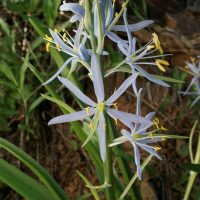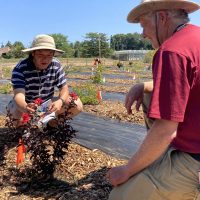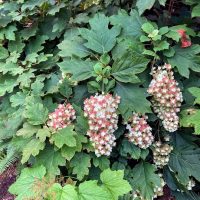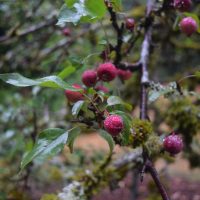Cusick’s Camas

By Paul Slichter
Local botanists have long recognized several patches of an odd camas growing above the Klickitat River. They didn’t quite match the Suksdorf’s camas (Camassia leichtlinii ssp. suksdorfii) or common camas (both C. quamash ssp. breviflora and ssp. quamash) which are the local camas in the area.
Fortunately, Susan Kephart, a specialist in camas taxonomy, was invited to look at the unusual camas by local plant enthusiast, Barbara Robinson.
September Specials at the Washington Park Arboretum

1) Schefflera delavayi Delavay’s Schefflera
Unlike the Schefflera houseplant that may seem familiar to some, this interesting character is cold hardy and grows exceptionally well in outdoor Pacific Northwest settings.
Bold evergreen leaves form an umbrella-like canopy. As the new leaves slowly develop, they are covered in tan indumentum, but eventually become a beautiful dark green.
Pale yellow flower spikes reaching upwards of three feet emerge in early autumn for a unique display.
Climate-Ready Plant Trials Underway at UW Botanic Gardens

“This trial is significant as it really does put data to the observations–not just qualitatively, but quantitatively–about how plants are performing,” says Ray Larson, Curator of Living Collections at UWBG.
Read moreUW Farm Weekly Dirt: Purslane and Volunteers

Around The Farm
For the third year, the UW Farm is hosting an AmeriCorps volunteer, a full-time 10-month position to help the Farm Manager with production, education and assists with all aspects of running an urban, campus farm, This is a unique opportunity for the volunteer who learns all aspects of an urban farm. In return AmeriCorps members act as mentors, lead programs and support the Farm Manager
AmeriCorps is a federal program that lists positions across the nation, “connecting individuals and organizations to tackle the nation’s most pressing challenges.” AmeriCorps is a federal agency that funds organizations to make positive impact in communities.
UW Botanic Gardens Makes Major Contribution to Tree Book

“It was probably the largest request we’ve ever received, which really speaks to the breadth of our collection and that we can grow so many kinds of trees in our temperate climate,” says Larson.
Read moreLate Summer Interest at the Washington Park Arboretum

1) Hydrangea quercifolia ‘Brido’ Oakleaf Hydrangea
Oakleaf Hydrangeas are native to the American South and are prized in horticulture for their distinctive oak-shaped leaves, reddish peeling bark, and large pyramids of flowers.
‘Brido’ features large double flowers that morph from white to pink with age.
You can find these showy shrubs around the Graham Visitors Center’s southern patio.
2) Billardiera longiflora Climbing Blueberry
This small evergreen vine is native to Australia and is most common in Tasmania, but also grows in New South Wales.
Read moreCounting the Endangered Wenatchee Mountains Checkermallow

We can now answer the question, with a high degree of confidence, of just how many Wenatchee Mountains checkermallow (Sidalcea oregana var. calva) plants there are. That’s due to a 9-year effort to count and map its largest known population at Camas Lands near Peshastin, WA. This population holds nearly 90% of all known individuals of this species; therefore, it is important to know how large this population is and how it is changing over time.
Read moreWelcome to Anna Carragee, New Rare Care Program Staff Member

“I love getting the reports back from rare plant monitoring volunteers–hearing how their searches went and seeing photos from successful hunts.”
Read moreA Town Called Malus

This week’s selections honor the area we call Crabapple Meadow and the residing collections therein. Each summer, the Meadow becomes home base for our annual summer camp participants and instructors and with this year’s season winding down, we feel it is a good time to recognize a handful of our terrific Malus specimens.
1) Malus ‘Sundog’
The “Flowering Crabs” comprise a genus of some 35 species of deciduous trees found throughout northern temperate regions.
Read more